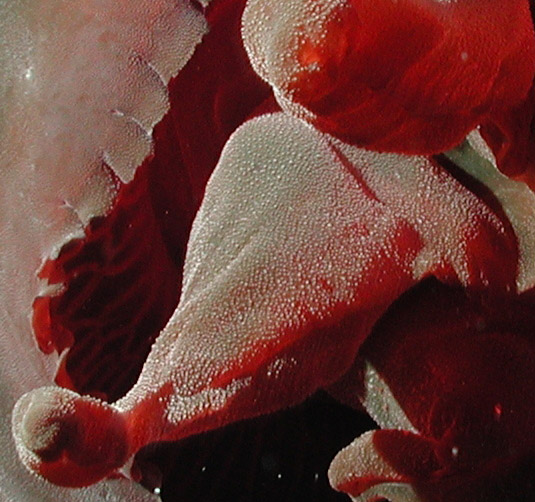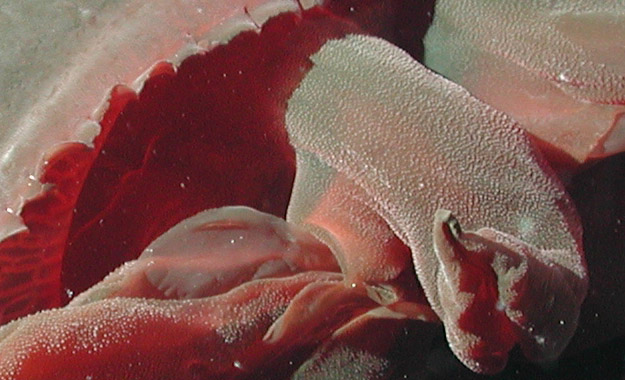|
|
|||||
|
Granrojo or Big Red ..
Granrojo or big red, Tiburonia granrojo, is a recently discovered jellyfish of the family Ulmaridae, the only member of its genus yet identified. It is one of the largest sea jellies and unusual in a number of ways. Tiburonia granrojo live at ocean depths of between 600 and 1500 metres and have been found across the Pacific Ocean in the Sea of Cortez, Monterey Bay, Hawaii and Japan. They grow to between 60 and 90 cm (2 to 3 feet) in diameter and have thick fleshy oral arms in place of the long tentacles found in most jellies. The entire jellyfish is deep red in color. To date, only 23 members of the species have been found and only one, a small specimen (under 15 cm) has been retrieved for further study. Several high resolution videos of granrojo have been taken by remote controlled submarines. Its discovery was announced by George Matsumoto and colleagues in Marine Biology in 2003. SOURCE: Wikipedia Granrojo
Related Links:
|
|||||
|
Dumbo Octopus ..
The octopuses of the genus Grimpoteuthis are also known as "Dumbo octopuses" from the ear-like fins protruding from the top of their head-like bodies, resembling the ears of Walt Disney's flying elephant. They are benthic creatures, living at extreme depths: 3000-4000 meters, and are some of the rarest of the Octopoda species. They can flush the transparent layer of their skin at will, and are pelagic animals, as with all other cirrate octopuses, and unlike many other incirrate octopuses. They hover above the sea floor, searching for worms, bivalves, pelagic copepods, and other crustaceans. They move by pulsing their arms, shooting water through their funnel, or by waving their ear-like fins. They can use each of these techniques separately or all simultaneously. The males and females are different in their size and sucker patterns. The females lay eggs consistently, with no distinct breeding season. SOURCE: Wikipedia Grimpoteuthis Related Links:
.. Octopus at the FeMO Microbial Observatory .. |
|||||
|
..
The small Benthocodon jelly has been found near sea mountains, some of which dwarf the Himalayas. Related Links:
.. |
|||||
|
..
Related Links: |
|||||
|
..
Related Links: |
|||||
|
..
Chondrocladia is a genus of carnivorous demosponges of the family Cladorhizidae of mycalinan Poecilosclerida. Neocladia was long considered a junior synonym, but has recently become accepted as a distinct genus. 32 named species are placed in this genus at present, but at least two additional undescribed ones are known to exist, while some of the described ones are known only from a few specimens or (e.g. the enigmatic Chondrocladia occulta) just a single one, and their validity and/or placement in Chondrocladia is doubtful. Chondrocladia sponges are stipitate, with a stalk frequently anchored in the substrate by rhizoids and an egg-shaped body, sometimes with branches that end in inflatable spheres. Fossils assignable to this genus are known since the Pleistocene, less than 2 million years ago. But given its deep sea habitat, Chondrocladia may well have been around for much longer – perhaps since the Mesozoic, as characteristic spicules (termed "microcricorhabds" or "trochirhabds"), almost identical to those of some living Chondrocladia, are known from Early Jurassic rocks almost 200 million years old SOURCE: Wikipedia Chondrocladia Related Links: |
|||||
| FAIR USE NOTICE: This page contains copyrighted material the use of which has not been specifically authorized by the copyright owner. Pegasus Research Consortium distributes this material without profit to those who have expressed a prior interest in receiving the included information for research and educational purposes. We believe this constitutes a fair use of any such copyrighted material as provided for in 17 U.S.C § 107. If you wish to use copyrighted material from this site for purposes of your own that go beyond fair use, you must obtain permission from the copyright owner. | |||||
|
|













